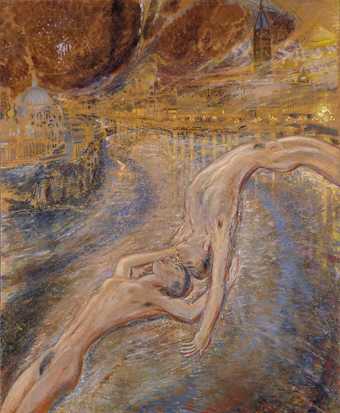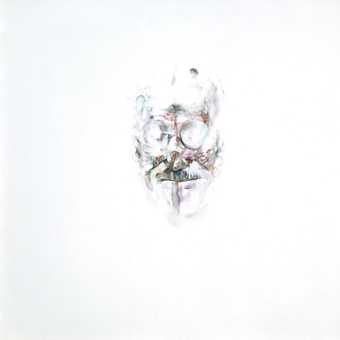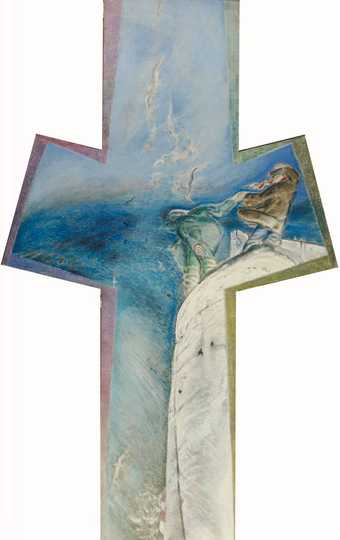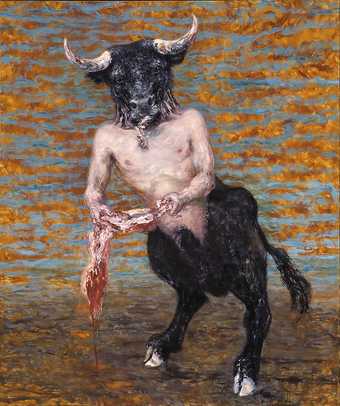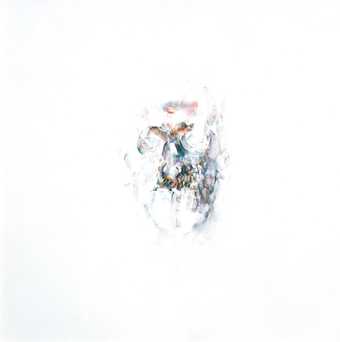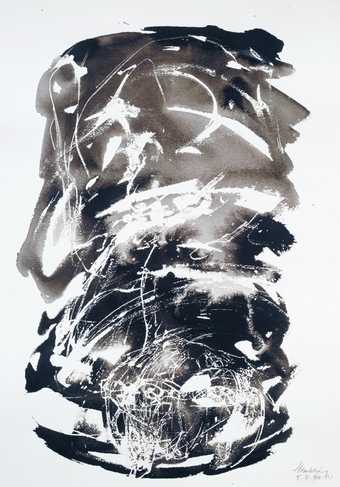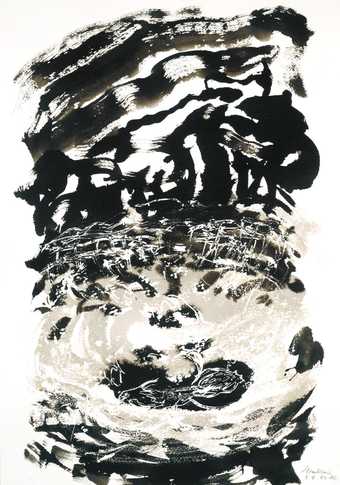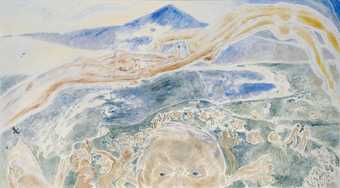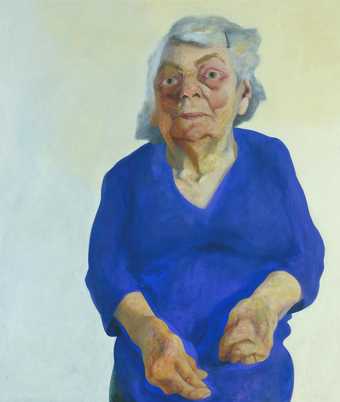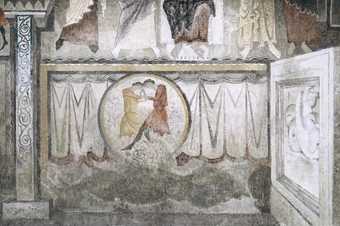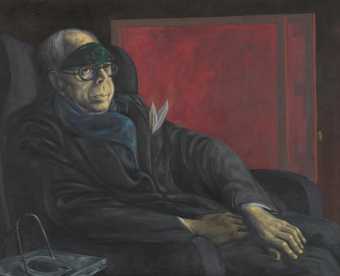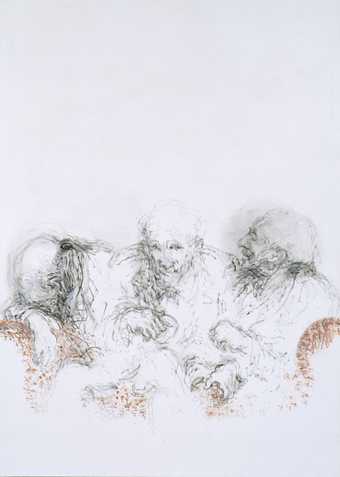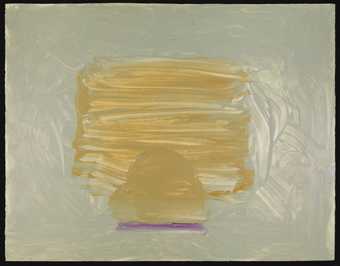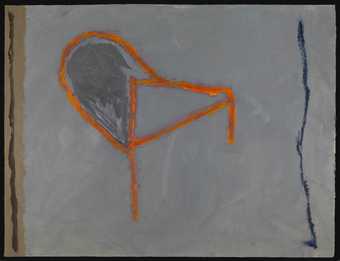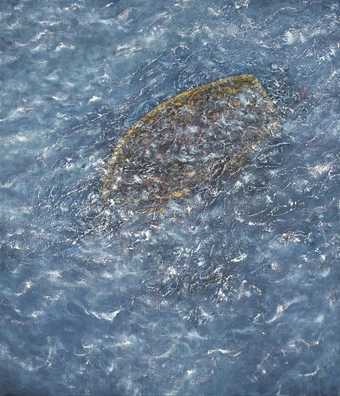
Not on display
- Artist
- Maggi Hambling born 1945
- Medium
- Oil paint on canvas
- Dimensions
- Support: 1677 × 1219 mm
- Collection
- Tate
- Acquisition
- Presented by the Trustees of the Chantrey Bequest 1983
- Reference
- T03542
Catalogue entry
T03542 Max Wall and his Image 1981
Oil on canvas 66 × 48 (1677 × 1219)
Inscribed ‘Hambling/1981’ on reverse
Presented by the Trustees of the Chantrey Bequest 1983
Exh:
Max Wall. Pictures by Maggi Hambling, National Portrait Gallery March–May 1983, John Hansard Gallery, Southampton, May–June 1983, Newlyn Art Gallery, Penzance, September–October 1983 (1, repr. in National Portrait Gallery catalogue); The Hard-Won Image, Tate Gallery, July–September 1984 (66, repr.); Artist and Model, Whitworth Art Gallery, Manchester, May–July 1986 (19, repr.)
Lit: Maggi and Max, Channel 4, 27 March 1983, directed by Judy Marle
The actor Max Wall was born in London in 1908. He has been well-known for many years as a music-hall entertainer; his performances include Jarry's ‘Ubu Roi’ at the Royal Court, Beckett's ‘Krapp's Last Tape’ at Greenwich Theatre and Riverside Studios, and the BBC and Roundhouse productions of ‘Waiting for Godot’. Extensive biographical notes on Max Wall are given in the catalogue of Maggi Hambling's Max Wall exhibition at the National Portrait Gallery (cited above) pp.32–3.
The following information is based on a conversation with the artist on 14 April 1986.
Maggi Hambling first saw Max Wall when he was performing as Ubu in Jarry's ‘Ubu Roi’ at the Royal Court Theatre in 1966. In spring 1981, towards the end of her appointment as first Artist in Residence at the National Gallery, she saw him in his one man show, ‘Aspects of Max Wall’ at the nearby Garrick Theatre. After seeing the show for a second time, again moved by his performance, Maggi Hambling wrote to Max Wall asking him if he would sit for a portrait. This was the first time that she had approached a sitter in this way. In the catalogue of her Max Wall exhibition at the National Portrait Gallery (cited above), p.10, Maggi Hambling wrote:
He has the true face of the sad clown, and possesses that power I can only call magical to make one laugh and cry at the same moment. My first painting in oils at the age of fourteen was of a clown, and at various times over the years I have attempted this subject. The contradictory aspects of the clown's nature fascinate me. I believe that the art of the clown in demonstrating to us the absurdities of life is a very necessary part of life.
‘Max Wall and his Image’ is Maggi Hambling's first painting of Max Wall. It was painted in five sittings in the spring of 1981. The setting is the artist's studio in Tennyson Street in South London. Maggi Hambling set the stage by hanging up a black curtain and placing stools on drawing boards, themselves raised on crates. When setting up this precarious arrangement Maggi Hambling did not realise that Max Wall had been an acrobat during his early career. To decide on the pose she made two quick working drawings. They are reproduced in the catalogue of the National Portrait Gallery exhibition (cited above), p.11.
The artist borrowed a large photograph of Max Wall's celebrated character Professor Wallofski and pinned it to the wall of her studio, beside the black curtain, before his first visit. In T03542 the shadow of Wallofski hovers behind his right shoulder. This is the image that is most generally associated with the actor. During sittings Max Wall referred to it as ‘the monster’; he felt that he was followed everywhere by Wallofski. The artist feels that the portrait shows him ‘as he is, my response to him, as I saw him’. The Wallofski section of the painting was repainted several times, including three different versions of the shadow walking from behind the curtain. The final version has been turned around and simplified almost to a silhouette.
The artist asked Max Wall to wear for the sittings the costume he had worn during the first half of his one man show, the part of the performance that had particularly moved her.
The first ovoid shape to appear in the painting was the door handle, which from a particular angle appeared to resemble an egg. During a rest between sittings Max Wall picked up a white alabaster egg and demonstrated one of his conjuring tricks to the artist. He later gave Maggi Hambling a black glass egg as a present. A white and black egg can be seen flying in the picture space in the Tate's painting.
The moon, in the top left hand corner, is a doubly significant reference to night time. Max Wall's working life as an actor takes place mostly in the evenings. Also Maggi Hambling fetched the actor for sittings at lunchtimes, and contrary to her normal practice, the sitting and conversations went on well into the night.
Max Wall smoked continuously between sittings and his butts and St Moritz cigarette packet appear in the foreground of the painting. Most of the Tate's picture is painted from life, directly representing Max Wall as he appeared on the stage Maggi Hambling had arranged, with the studio door beyond. Only the part of the painting to the left and immediately behind the sitter (the wall colour, the eggs, the moon and the final image of Wallofski) come from the imagination. Maggi Hambling points out that for her ‘a portrait is first and foremost a painting and secondarily a portrait’.
Starting with the Tate's picture Max Wall became the subject of Maggi Hambling's work for nearly two years. The catalogue of her Max Wall exhibition lists thirty-eight works (fifteen of them canvases) representing him with subjects connected with him. Almost all are reproduced; they include ‘Max's Egg’ 1982, in which one of the items seen on the crowded mantelpiece of Maggi Hambling's studio is a photograph of the Tate's painting.
This entry has been approved by the artist.
Published in:
The Tate Gallery 1982-84: Illustrated Catalogue of Acquisitions, London 1986
Explore
- architecture(30,960)
- places of entertainment(399)
-
- theatre(70)
- studio(549)
- recreational activities(2,836)
-
- juggling(5)
- clothing and personal items(5,879)
-
- cigarette(89)
- cigarette packet(17)
- ashtray(23)
- actions: postures and motions(9,111)
-
- sitting(3,347)
- man, old(373)
- Wall, Max(1)
- individuals: male(1,841)
- dress: fantasy/fancy(506)
-
- clown costume(24)
- arts and entertainment(7,210)
You might like
-
Jeffery Camp Rocket Over Venice
1986 -
Louis Le Brocquy Study Towards an Image of James Joyce
1977 -
Jeffery Camp Beachy Head: Brink
1975 -
Maggi Hambling Minotaur Surprised while Eating
1986–7 -
Louis Le Brocquy Image of James Joyce
1977 -
Maggi Hambling Mud Dream 1
1990 -
Maggi Hambling Mud Dream 6
1990 -
Jeffery Camp Southcoast
1990 -
Maggi Hambling Portrait of Frances Rose
1973 -
Valerie Thornton Bominaco (The Abruzzi)
1988 -
Michael Ayrton Portrait of Wyndham Lewis
1955 -
Maggi Hambling Father, Late December 1997
1997 -
Trevor Bell Dust Image
1988 -
Trevor Bell Image
1989 -
Maggi Hambling 2016
2016

